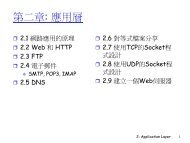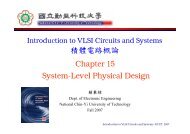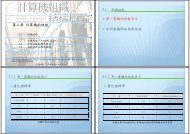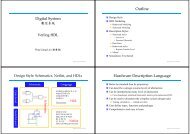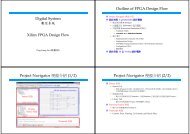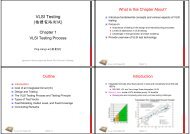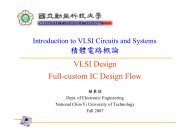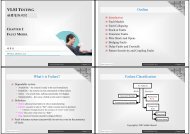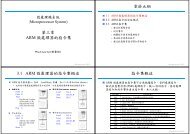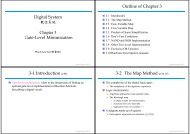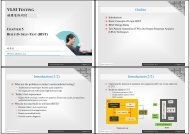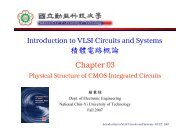Chapter 3 Testability Measure.pdf
Chapter 3 Testability Measure.pdf
Chapter 3 Testability Measure.pdf
Create successful ePaper yourself
Turn your PDF publications into a flip-book with our unique Google optimized e-Paper software.
<strong>Testability</strong> <strong>Measure</strong>s (2/3)<br />
<strong>Testability</strong> <strong>Measure</strong>s (2/3)<br />
<strong>Testability</strong> measures used to get approximate measure of:<br />
Difficulty of setting internal circuit lines to 0 or 1 by setting primary<br />
circuit inputs<br />
Difficulty of observing internal circuit lines by observing primary<br />
outputs<br />
This knowledge can be used to:<br />
Provided analysis of difficulty of testing internal circuit parts, might<br />
require redesigning or addition of special testing hardware<br />
Provides guidance for algorithms performing test pattern generation,<br />
avoid using hard-to-control lines<br />
Provides an estimation of fault coverage<br />
Provides an estimation of test vector length<br />
Controllability: difficulty in setting a particular circuit node to 0 or 1<br />
Observability: difficulty of observing the state of a logic signal<br />
P.L.Lai, VLSI Testing 2010 <strong>Chapter</strong> 3-5<br />
<br />
<br />
<strong>Testability</strong> analysis attributes:<br />
Involves circuit topology analysis, but no test vectors<br />
It has linear complexity, otherwise it is pointless and one might as well<br />
use automatic test pattern generation (ATPG) algorithms<br />
The origin of testability measures is in control theory. Several<br />
algorithms have been proposed:<br />
Rutman 1972: first definition of controllability<br />
Goldstein 1979: SCOAP<br />
<br />
<br />
<br />
» First definition of observability<br />
» First elegant formulation<br />
» First efficient algorithm to compute controllability and observability<br />
Parker and McCluskey 1975: definition of probabilistic controllability<br />
Brglez 1984: COP<br />
» First probabilistic measures<br />
Seth, Pan and Agrawal 1985: PREDICT<br />
» First exact probabilistic measures<br />
P.L.Lai, VLSI Testing 2010 <strong>Chapter</strong> 3-6<br />
<strong>Testability</strong> Analysis - SCOAP<br />
SCOAP Controllability (1/2)<br />
Goldstein's algorithm: SCOAP<br />
We will focus mainly on combinational circuits<br />
<br />
Controllabilities: set Primary Input (PI) controllabilities to 1, progress<br />
from PIs to Primary Outputs (POs), add 1 to account for logic depth<br />
General rules for setting controllabilities<br />
<br />
If only one input sets gate output:<br />
» Output controllability = min (input controllabilites) + 1<br />
If all inputs set gate output:<br />
» Output controllability = sum (input controllabilities) + 1<br />
If gate output is determined by multiple input sets, e.g., XOR:<br />
» Output controllability = min(controllabilities of input sets) + 1<br />
CC0(a), CC1(a)<br />
CC0(b), CC1(b)<br />
a<br />
b<br />
a<br />
b<br />
a<br />
b<br />
a<br />
b<br />
a<br />
b<br />
a<br />
b<br />
z<br />
z<br />
z<br />
z<br />
z<br />
z<br />
CC0(z)=min{(CC0(a), CC0(b)}+1<br />
CC1(z)=CC1(a)+CC1(b)+1<br />
CC0(z)=CC0(a)+CC0(b)+1<br />
CC1(z)=min{(CC1(a), CC0(b)}+1<br />
CC0(z)=min{(CC0(a)+CC0(b), CC1(a)+CC1(b)}+1<br />
CC1(z)= min{(CC1(a)+CC0(b), CC0(a)+CC1(b)}+1<br />
CC0(z)=CC1(a)+CC1(b)+1<br />
CC1(z)=min{(CC0(a), CC0(b)}+1<br />
CC0(z)=min{(CC1(a), CC1(b)}+1<br />
CC1(z)=CC0(a)+CC0(b)+1<br />
CC0(z)=min{(CC1(a)+CC0(b), CC0(a)+CC1(b)}+1<br />
CC1(z)= min{(CC0(a)+CC0(b), CC1(a)+CC1(b)}+1<br />
a<br />
z<br />
CC0(z)=CC1(a)+1<br />
CC1(z)=CC0(a)+1<br />
P.L.Lai, VLSI Testing 2010 <strong>Chapter</strong> 3-7<br />
P.L.Lai, VLSI Testing 2010 <strong>Chapter</strong> 3-8



